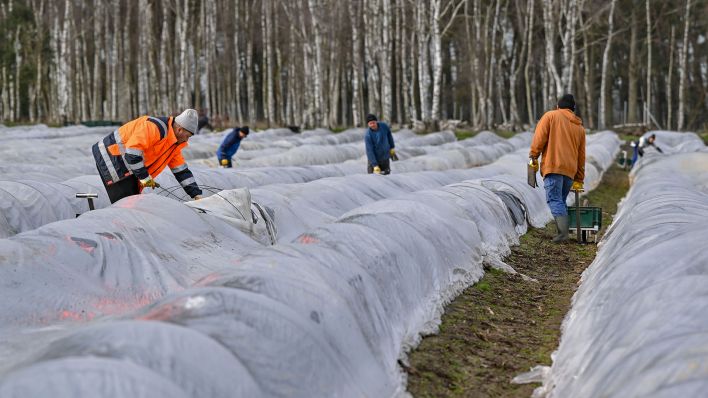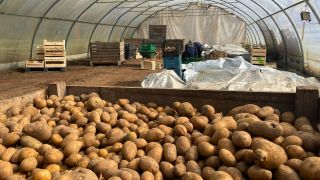start of season
–
“Without foil, no marketable asparagus can be produced”
Asparagus is considered a traditional harbinger of spring on the plate, but in Brandenburg the area under cultivation is shrinking. Farmers are struggling with higher costs and uncertainties when it comes to purchasing. But there is also confidence at the start of the season.
Harvest workers have pricked the first asparagus spears in the fields. But for the upcoming Easter festival, the local vegetables, which need warmth and sun, will only be available in small quantities.
The asparagus growers in Brandenburg have been looking expectantly at the weather forecast for days: Sunny spring weather with 15 to 20 degrees is ideal for the asparagus. “We will not have enough asparagus before Easter,” estimates the chairman of the Beelitz asparagus association, Jürgen Jakobs. In the season that lasts until June, however, he expects a good harvest. Asparagus from Beelitz, the largest growing area in Brandenburg southwest of Berlin and Potsdam with a long tradition, is also widely represented in retail.
“We were actually the big Corona winners too”
According to Jakobs, however, the past year was rather bad for the asparagus farmers: “2022 was characterized by extreme reluctance to buy.” According to the association, German asparagus remained in the shops. Customers were unsettled by the energy crisis and might have bought cheaper asparagus from abroad. In 2022, most companies would not have closed with a profit, said Jakobs.
The German Farmers’ Association recently even expressed concern that German asparagus could one day disappear from the fields because of cheaper imported goods. It seems clear so far: In Brandenburg, at least, the area under cultivation is getting smaller. “Some farmers said we’re going out of production,” said Jürgen Jakobs, chairman of the Beelitz asparagus association, describing the situation.
Malte Voigts, managing director of the asparagus farm in the small town of Kremmen, also wants to reduce his area for the yield from around 180 hectares to 150 to 120 hectares, but is optimistic about the asparagus business that started on April 1st. “We were actually the big Corona winners too,” he said, recalling the time when more people cooked at home with fresh ingredients due to the Corona restrictions.
Brandenburg in third place nationwide
Malte Voigts from Spargelhof Kremmen in the district of Oberhavel does not see asparagus as a local spring vegetable, a German cultural asset in a sense, in danger. He is looking at the start of the season in a good mood, even if consumers could possibly save on consumption this year, he says. Brandenburg is also not in a bad position in a nationwide comparison: According to figures from the Federal Statistical Office, Brandenburg was in third place nationwide for the asparagus harvest with 18,700 tons – after Lower Saxony and North Rhine-Westphalia.
Are sales prices also rising sharply due to higher production costs and the statutory minimum wage of 12 euros, which is having an impact on harvest workers this season? “That’s going to hit the office,” Jakobs said of wage increases of up to 25 percent. Greek or Spanish asparagus, for example, is cheaper to produce. “But we’re trying to keep the old prices.” A good variety costs twelve to 15 euros per kilo.
Asparagus expert Voigts from Kremmen cites a price range of six to 16 euros for its range of different qualities – that is the previous year’s level. He is trying to compensate for the increase in the minimum wage for his around 250 harvest workers from Poland and Romania, for example with increases in efficiency and younger asparagus cultures in the fields.
Criticized by conservationists
In order for the asparagus to sprout early from the sandy soil, it grows under plastic almost everywhere during the three-month season. The foils, which are controversial among nature conservationists because of species protection, can be used to influence the temperature in the asparagus dam and thus produce a faster harvest. “You can’t produce marketable asparagus without foil,” said Jakobs. The price would be much higher, and the asparagus tips would turn green or blue without a cover, which consumers in turn despise.
Managing Director Malte Voigts also mentions the advantages of the film, which lasts around eight to ten years. For example, he can do without herbicides against weeds, and water can also be saved. But opinions differ.
In Brandenburg an der Havel, a heated argument raged between farmers and conservationists because of the foils in a bird sanctuary. Asparagus farmer Scharkowski in southern Brandenburg with a comparatively very small area of almost ten hectares swears by film-free cultivation as a unique selling point, as he said. “That’s why many customers come to us.” He can harvest the first asparagus in a few weeks. “We hope for the end of April, beginning of May.”
Broadcast: rbb24 Brandenburg aktuell, April 2nd, 2023, 7.30 p.m

